Organisational Behaviour, Motivation, and Team Dynamics: Primark
VerifiedAdded on 2023/01/12
|13
|3744
|57
Report
AI Summary
This report examines the organisational behaviour of Primark, a retail company, focusing on the impact of organisational culture, politics, and power on individual and team behaviour. It applies Hofstede's cultural theory and French and Raven's theory of power to analyse Primark's structure. The report also investigates the influence of content and process theories of motivation, including Maslow's hierarchy of needs and equity theory, on achieving organisational goals. Furthermore, it differentiates between effective and ineffective teams, highlighting key factors in decision-making and open communication. Finally, the report explores the concepts and philosophies of organisational behaviour in the context of Primark, providing a comprehensive overview of its workforce dynamics and management strategies.
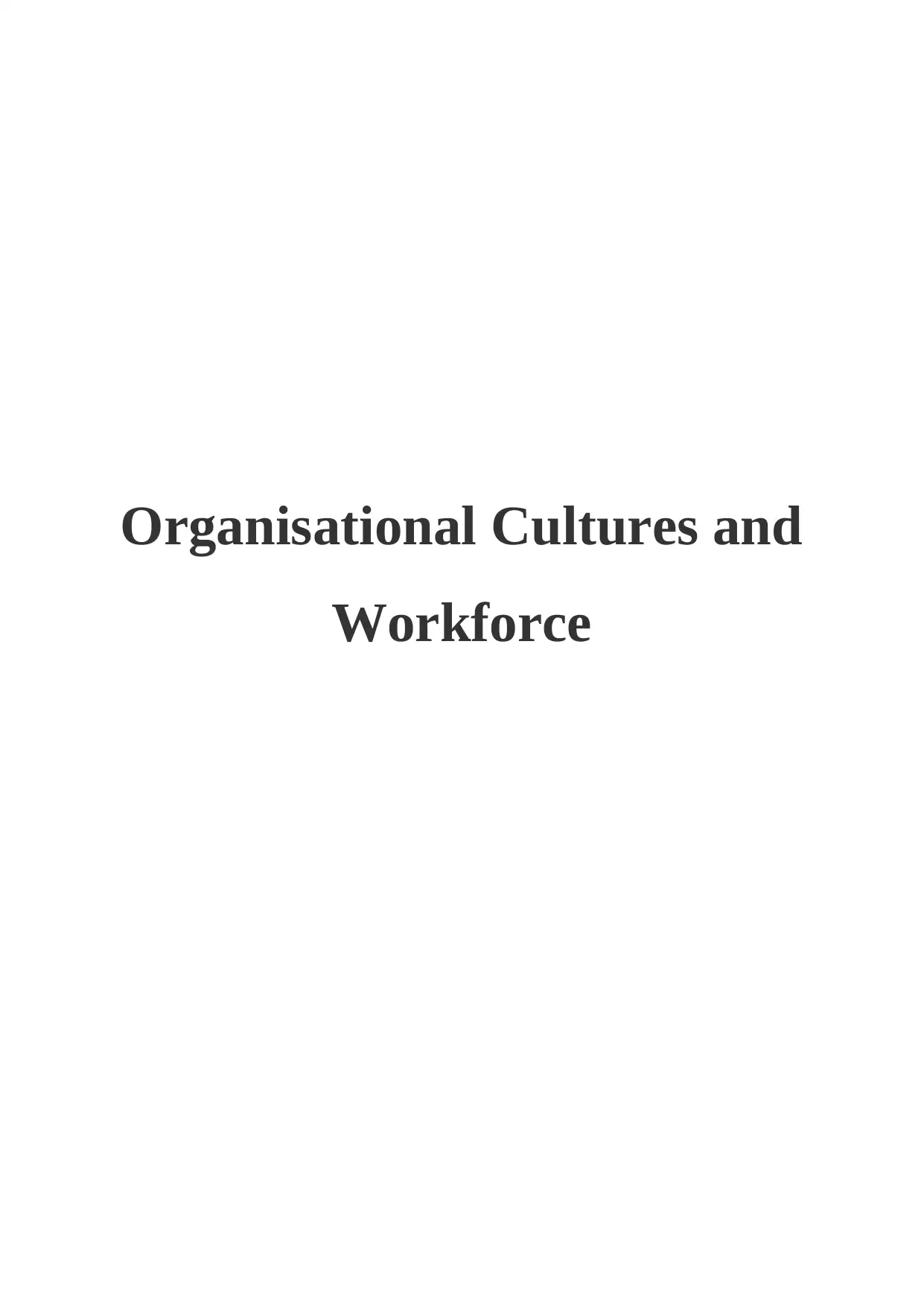
Organisational Cultures and
Workforce
Workforce
Paraphrase This Document
Need a fresh take? Get an instant paraphrase of this document with our AI Paraphraser
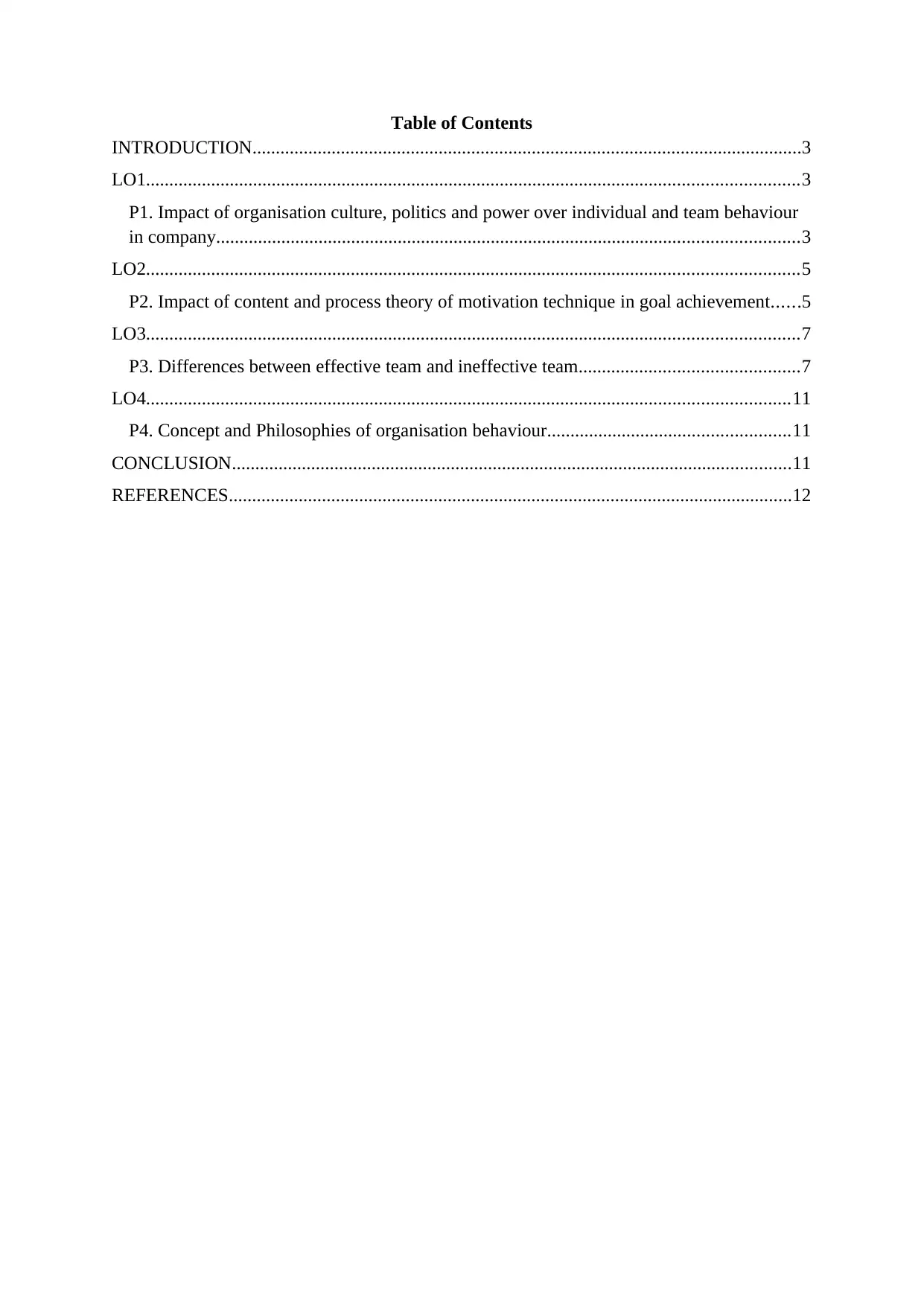
Table of Contents
INTRODUCTION......................................................................................................................3
LO1............................................................................................................................................3
P1. Impact of organisation culture, politics and power over individual and team behaviour
in company.............................................................................................................................3
LO2............................................................................................................................................5
P2. Impact of content and process theory of motivation technique in goal achievement......5
LO3............................................................................................................................................7
P3. Differences between effective team and ineffective team...............................................7
LO4..........................................................................................................................................11
P4. Concept and Philosophies of organisation behaviour....................................................11
CONCLUSION........................................................................................................................11
REFERENCES.........................................................................................................................12
INTRODUCTION......................................................................................................................3
LO1............................................................................................................................................3
P1. Impact of organisation culture, politics and power over individual and team behaviour
in company.............................................................................................................................3
LO2............................................................................................................................................5
P2. Impact of content and process theory of motivation technique in goal achievement......5
LO3............................................................................................................................................7
P3. Differences between effective team and ineffective team...............................................7
LO4..........................................................................................................................................11
P4. Concept and Philosophies of organisation behaviour....................................................11
CONCLUSION........................................................................................................................11
REFERENCES.........................................................................................................................12
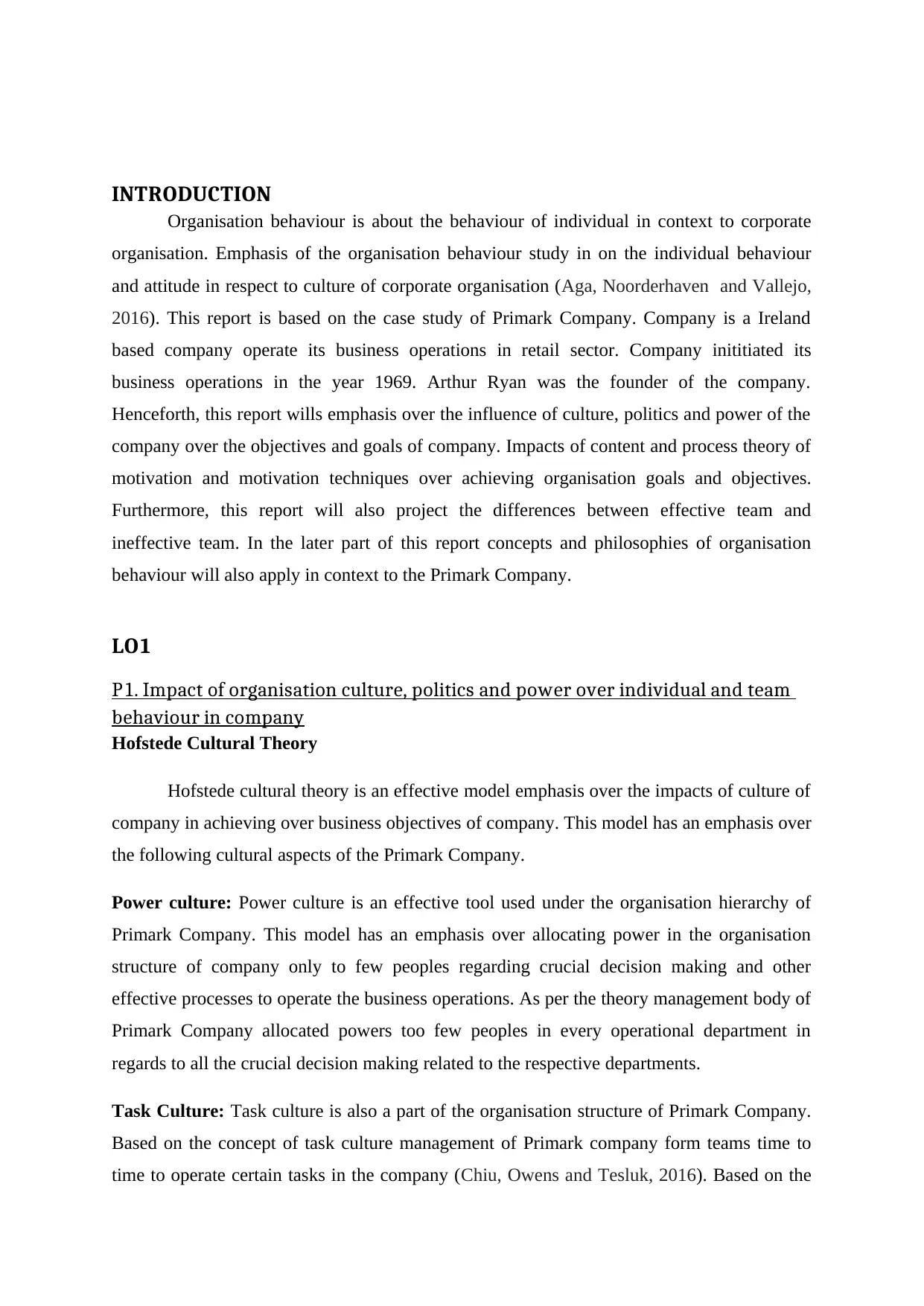
INTRODUCTION
Organisation behaviour is about the behaviour of individual in context to corporate
organisation. Emphasis of the organisation behaviour study in on the individual behaviour
and attitude in respect to culture of corporate organisation (Aga, Noorderhaven and Vallejo,
2016). This report is based on the case study of Primark Company. Company is a Ireland
based company operate its business operations in retail sector. Company inititiated its
business operations in the year 1969. Arthur Ryan was the founder of the company.
Henceforth, this report wills emphasis over the influence of culture, politics and power of the
company over the objectives and goals of company. Impacts of content and process theory of
motivation and motivation techniques over achieving organisation goals and objectives.
Furthermore, this report will also project the differences between effective team and
ineffective team. In the later part of this report concepts and philosophies of organisation
behaviour will also apply in context to the Primark Company.
LO1
P1. Impact of organisation culture, politics and power over individual and team
behaviour in company
Hofstede Cultural Theory
Hofstede cultural theory is an effective model emphasis over the impacts of culture of
company in achieving over business objectives of company. This model has an emphasis over
the following cultural aspects of the Primark Company.
Power culture: Power culture is an effective tool used under the organisation hierarchy of
Primark Company. This model has an emphasis over allocating power in the organisation
structure of company only to few peoples regarding crucial decision making and other
effective processes to operate the business operations. As per the theory management body of
Primark Company allocated powers too few peoples in every operational department in
regards to all the crucial decision making related to the respective departments.
Task Culture: Task culture is also a part of the organisation structure of Primark Company.
Based on the concept of task culture management of Primark company form teams time to
time to operate certain tasks in the company (Chiu, Owens and Tesluk, 2016). Based on the
Organisation behaviour is about the behaviour of individual in context to corporate
organisation. Emphasis of the organisation behaviour study in on the individual behaviour
and attitude in respect to culture of corporate organisation (Aga, Noorderhaven and Vallejo,
2016). This report is based on the case study of Primark Company. Company is a Ireland
based company operate its business operations in retail sector. Company inititiated its
business operations in the year 1969. Arthur Ryan was the founder of the company.
Henceforth, this report wills emphasis over the influence of culture, politics and power of the
company over the objectives and goals of company. Impacts of content and process theory of
motivation and motivation techniques over achieving organisation goals and objectives.
Furthermore, this report will also project the differences between effective team and
ineffective team. In the later part of this report concepts and philosophies of organisation
behaviour will also apply in context to the Primark Company.
LO1
P1. Impact of organisation culture, politics and power over individual and team
behaviour in company
Hofstede Cultural Theory
Hofstede cultural theory is an effective model emphasis over the impacts of culture of
company in achieving over business objectives of company. This model has an emphasis over
the following cultural aspects of the Primark Company.
Power culture: Power culture is an effective tool used under the organisation hierarchy of
Primark Company. This model has an emphasis over allocating power in the organisation
structure of company only to few peoples regarding crucial decision making and other
effective processes to operate the business operations. As per the theory management body of
Primark Company allocated powers too few peoples in every operational department in
regards to all the crucial decision making related to the respective departments.
Task Culture: Task culture is also a part of the organisation structure of Primark Company.
Based on the concept of task culture management of Primark company form teams time to
time to operate certain tasks in the company (Chiu, Owens and Tesluk, 2016). Based on the
⊘ This is a preview!⊘
Do you want full access?
Subscribe today to unlock all pages.

Trusted by 1+ million students worldwide
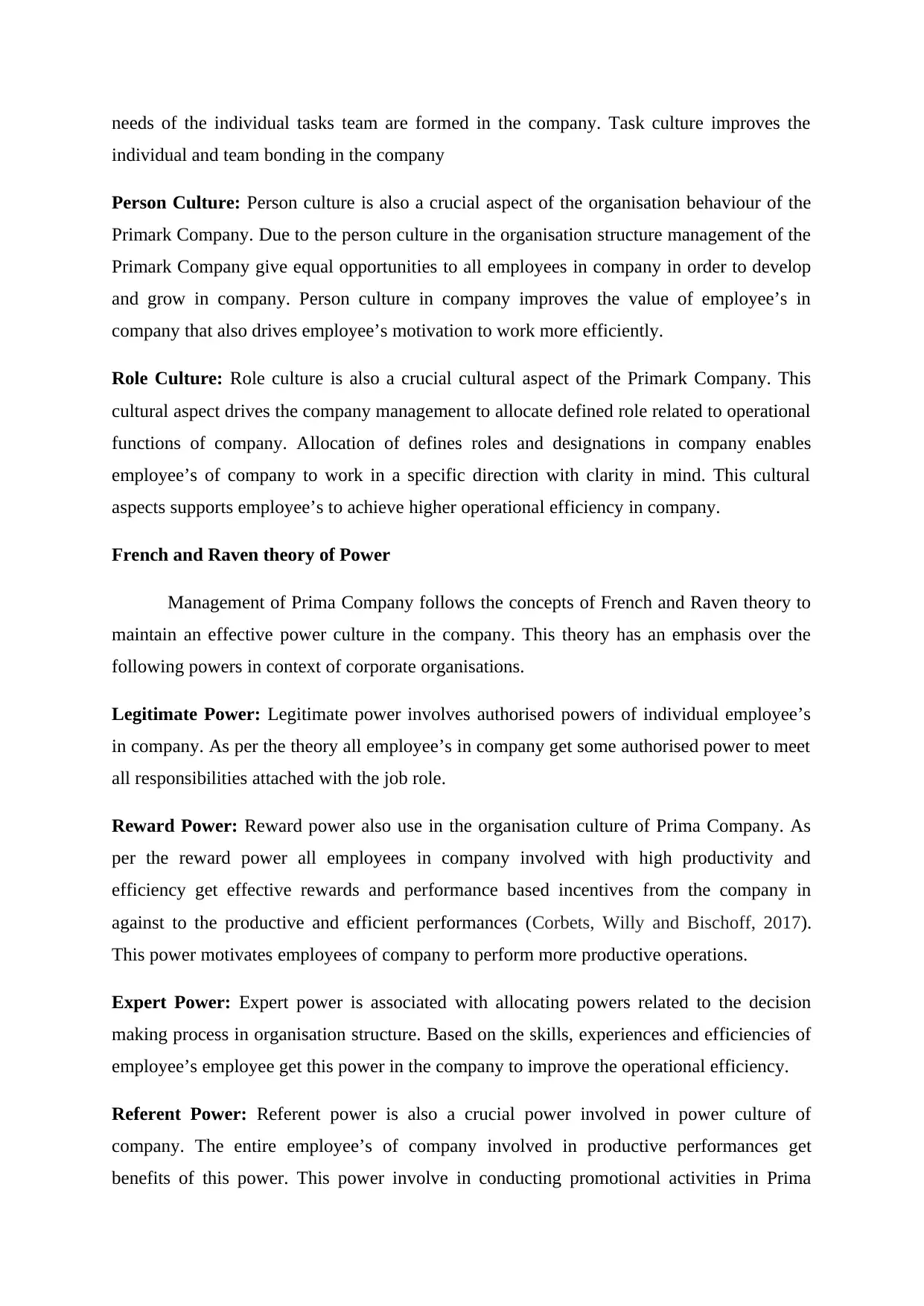
needs of the individual tasks team are formed in the company. Task culture improves the
individual and team bonding in the company
Person Culture: Person culture is also a crucial aspect of the organisation behaviour of the
Primark Company. Due to the person culture in the organisation structure management of the
Primark Company give equal opportunities to all employees in company in order to develop
and grow in company. Person culture in company improves the value of employee’s in
company that also drives employee’s motivation to work more efficiently.
Role Culture: Role culture is also a crucial cultural aspect of the Primark Company. This
cultural aspect drives the company management to allocate defined role related to operational
functions of company. Allocation of defines roles and designations in company enables
employee’s of company to work in a specific direction with clarity in mind. This cultural
aspects supports employee’s to achieve higher operational efficiency in company.
French and Raven theory of Power
Management of Prima Company follows the concepts of French and Raven theory to
maintain an effective power culture in the company. This theory has an emphasis over the
following powers in context of corporate organisations.
Legitimate Power: Legitimate power involves authorised powers of individual employee’s
in company. As per the theory all employee’s in company get some authorised power to meet
all responsibilities attached with the job role.
Reward Power: Reward power also use in the organisation culture of Prima Company. As
per the reward power all employees in company involved with high productivity and
efficiency get effective rewards and performance based incentives from the company in
against to the productive and efficient performances (Corbets, Willy and Bischoff, 2017).
This power motivates employees of company to perform more productive operations.
Expert Power: Expert power is associated with allocating powers related to the decision
making process in organisation structure. Based on the skills, experiences and efficiencies of
employee’s employee get this power in the company to improve the operational efficiency.
Referent Power: Referent power is also a crucial power involved in power culture of
company. The entire employee’s of company involved in productive performances get
benefits of this power. This power involve in conducting promotional activities in Prima
individual and team bonding in the company
Person Culture: Person culture is also a crucial aspect of the organisation behaviour of the
Primark Company. Due to the person culture in the organisation structure management of the
Primark Company give equal opportunities to all employees in company in order to develop
and grow in company. Person culture in company improves the value of employee’s in
company that also drives employee’s motivation to work more efficiently.
Role Culture: Role culture is also a crucial cultural aspect of the Primark Company. This
cultural aspect drives the company management to allocate defined role related to operational
functions of company. Allocation of defines roles and designations in company enables
employee’s of company to work in a specific direction with clarity in mind. This cultural
aspects supports employee’s to achieve higher operational efficiency in company.
French and Raven theory of Power
Management of Prima Company follows the concepts of French and Raven theory to
maintain an effective power culture in the company. This theory has an emphasis over the
following powers in context of corporate organisations.
Legitimate Power: Legitimate power involves authorised powers of individual employee’s
in company. As per the theory all employee’s in company get some authorised power to meet
all responsibilities attached with the job role.
Reward Power: Reward power also use in the organisation culture of Prima Company. As
per the reward power all employees in company involved with high productivity and
efficiency get effective rewards and performance based incentives from the company in
against to the productive and efficient performances (Corbets, Willy and Bischoff, 2017).
This power motivates employees of company to perform more productive operations.
Expert Power: Expert power is associated with allocating powers related to the decision
making process in organisation structure. Based on the skills, experiences and efficiencies of
employee’s employee get this power in the company to improve the operational efficiency.
Referent Power: Referent power is also a crucial power involved in power culture of
company. The entire employee’s of company involved in productive performances get
benefits of this power. This power involve in conducting promotional activities in Prima
Paraphrase This Document
Need a fresh take? Get an instant paraphrase of this document with our AI Paraphraser
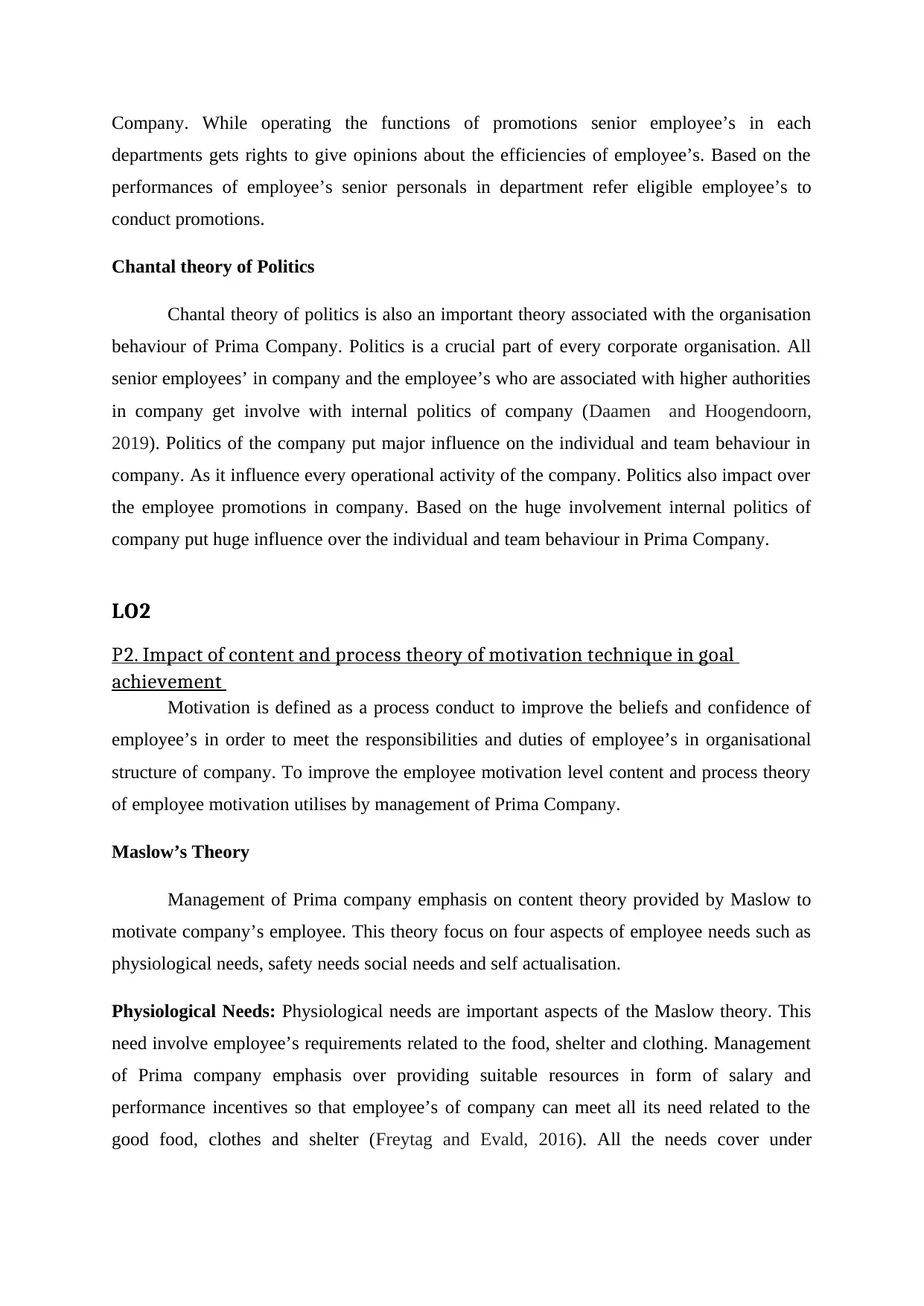
Company. While operating the functions of promotions senior employee’s in each
departments gets rights to give opinions about the efficiencies of employee’s. Based on the
performances of employee’s senior personals in department refer eligible employee’s to
conduct promotions.
Chantal theory of Politics
Chantal theory of politics is also an important theory associated with the organisation
behaviour of Prima Company. Politics is a crucial part of every corporate organisation. All
senior employees’ in company and the employee’s who are associated with higher authorities
in company get involve with internal politics of company (Daamen and Hoogendoorn,
2019). Politics of the company put major influence on the individual and team behaviour in
company. As it influence every operational activity of the company. Politics also impact over
the employee promotions in company. Based on the huge involvement internal politics of
company put huge influence over the individual and team behaviour in Prima Company.
LO2
P2. Impact of content and process theory of motivation technique in goal
achievement
Motivation is defined as a process conduct to improve the beliefs and confidence of
employee’s in order to meet the responsibilities and duties of employee’s in organisational
structure of company. To improve the employee motivation level content and process theory
of employee motivation utilises by management of Prima Company.
Maslow’s Theory
Management of Prima company emphasis on content theory provided by Maslow to
motivate company’s employee. This theory focus on four aspects of employee needs such as
physiological needs, safety needs social needs and self actualisation.
Physiological Needs: Physiological needs are important aspects of the Maslow theory. This
need involve employee’s requirements related to the food, shelter and clothing. Management
of Prima company emphasis over providing suitable resources in form of salary and
performance incentives so that employee’s of company can meet all its need related to the
good food, clothes and shelter (Freytag and Evald, 2016). All the needs cover under
departments gets rights to give opinions about the efficiencies of employee’s. Based on the
performances of employee’s senior personals in department refer eligible employee’s to
conduct promotions.
Chantal theory of Politics
Chantal theory of politics is also an important theory associated with the organisation
behaviour of Prima Company. Politics is a crucial part of every corporate organisation. All
senior employees’ in company and the employee’s who are associated with higher authorities
in company get involve with internal politics of company (Daamen and Hoogendoorn,
2019). Politics of the company put major influence on the individual and team behaviour in
company. As it influence every operational activity of the company. Politics also impact over
the employee promotions in company. Based on the huge involvement internal politics of
company put huge influence over the individual and team behaviour in Prima Company.
LO2
P2. Impact of content and process theory of motivation technique in goal
achievement
Motivation is defined as a process conduct to improve the beliefs and confidence of
employee’s in order to meet the responsibilities and duties of employee’s in organisational
structure of company. To improve the employee motivation level content and process theory
of employee motivation utilises by management of Prima Company.
Maslow’s Theory
Management of Prima company emphasis on content theory provided by Maslow to
motivate company’s employee. This theory focus on four aspects of employee needs such as
physiological needs, safety needs social needs and self actualisation.
Physiological Needs: Physiological needs are important aspects of the Maslow theory. This
need involve employee’s requirements related to the food, shelter and clothing. Management
of Prima company emphasis over providing suitable resources in form of salary and
performance incentives so that employee’s of company can meet all its need related to the
good food, clothes and shelter (Freytag and Evald, 2016). All the needs cover under
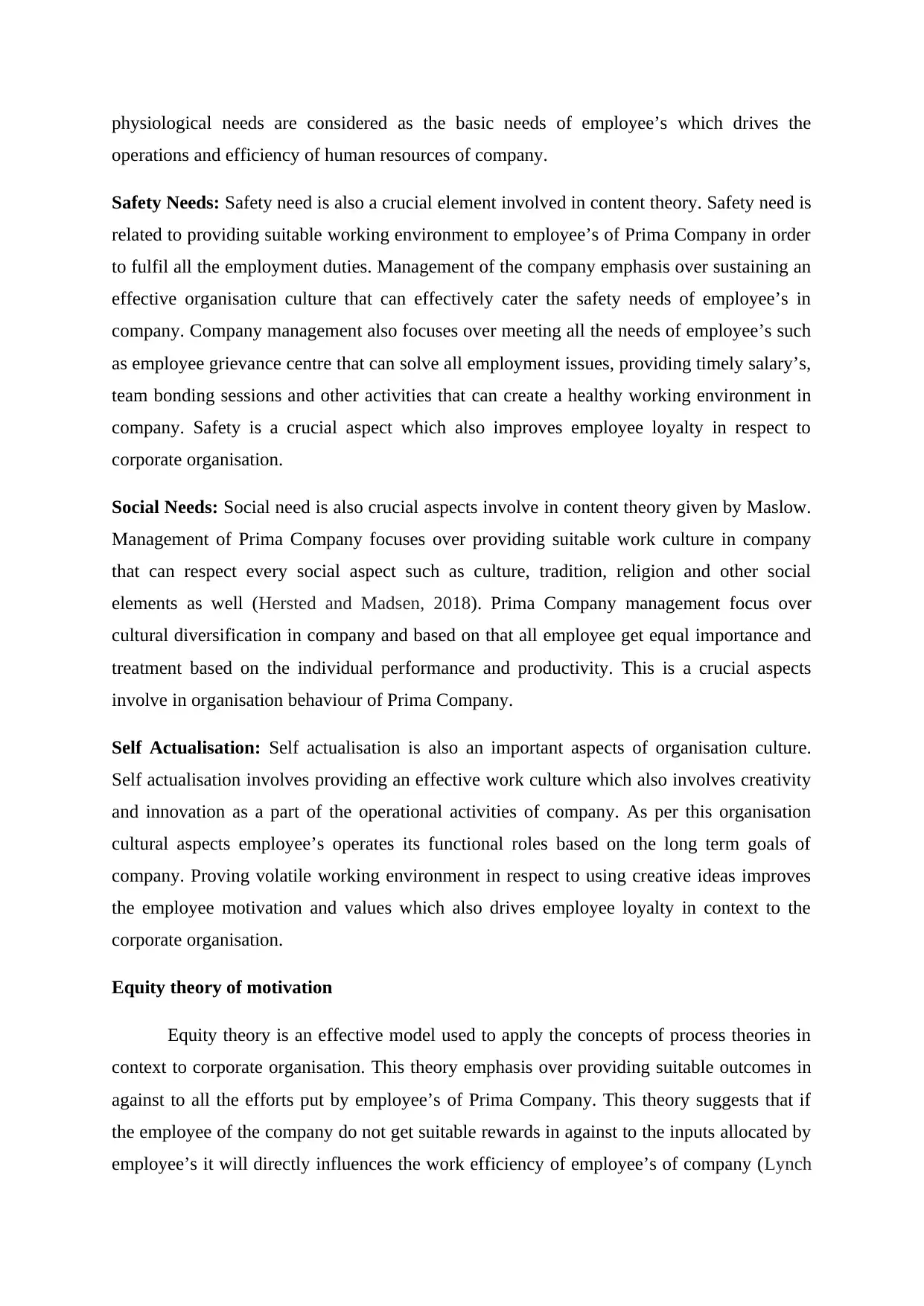
physiological needs are considered as the basic needs of employee’s which drives the
operations and efficiency of human resources of company.
Safety Needs: Safety need is also a crucial element involved in content theory. Safety need is
related to providing suitable working environment to employee’s of Prima Company in order
to fulfil all the employment duties. Management of the company emphasis over sustaining an
effective organisation culture that can effectively cater the safety needs of employee’s in
company. Company management also focuses over meeting all the needs of employee’s such
as employee grievance centre that can solve all employment issues, providing timely salary’s,
team bonding sessions and other activities that can create a healthy working environment in
company. Safety is a crucial aspect which also improves employee loyalty in respect to
corporate organisation.
Social Needs: Social need is also crucial aspects involve in content theory given by Maslow.
Management of Prima Company focuses over providing suitable work culture in company
that can respect every social aspect such as culture, tradition, religion and other social
elements as well (Hersted and Madsen, 2018). Prima Company management focus over
cultural diversification in company and based on that all employee get equal importance and
treatment based on the individual performance and productivity. This is a crucial aspects
involve in organisation behaviour of Prima Company.
Self Actualisation: Self actualisation is also an important aspects of organisation culture.
Self actualisation involves providing an effective work culture which also involves creativity
and innovation as a part of the operational activities of company. As per this organisation
cultural aspects employee’s operates its functional roles based on the long term goals of
company. Proving volatile working environment in respect to using creative ideas improves
the employee motivation and values which also drives employee loyalty in context to the
corporate organisation.
Equity theory of motivation
Equity theory is an effective model used to apply the concepts of process theories in
context to corporate organisation. This theory emphasis over providing suitable outcomes in
against to all the efforts put by employee’s of Prima Company. This theory suggests that if
the employee of the company do not get suitable rewards in against to the inputs allocated by
employee’s it will directly influences the work efficiency of employee’s of company (Lynch
operations and efficiency of human resources of company.
Safety Needs: Safety need is also a crucial element involved in content theory. Safety need is
related to providing suitable working environment to employee’s of Prima Company in order
to fulfil all the employment duties. Management of the company emphasis over sustaining an
effective organisation culture that can effectively cater the safety needs of employee’s in
company. Company management also focuses over meeting all the needs of employee’s such
as employee grievance centre that can solve all employment issues, providing timely salary’s,
team bonding sessions and other activities that can create a healthy working environment in
company. Safety is a crucial aspect which also improves employee loyalty in respect to
corporate organisation.
Social Needs: Social need is also crucial aspects involve in content theory given by Maslow.
Management of Prima Company focuses over providing suitable work culture in company
that can respect every social aspect such as culture, tradition, religion and other social
elements as well (Hersted and Madsen, 2018). Prima Company management focus over
cultural diversification in company and based on that all employee get equal importance and
treatment based on the individual performance and productivity. This is a crucial aspects
involve in organisation behaviour of Prima Company.
Self Actualisation: Self actualisation is also an important aspects of organisation culture.
Self actualisation involves providing an effective work culture which also involves creativity
and innovation as a part of the operational activities of company. As per this organisation
cultural aspects employee’s operates its functional roles based on the long term goals of
company. Proving volatile working environment in respect to using creative ideas improves
the employee motivation and values which also drives employee loyalty in context to the
corporate organisation.
Equity theory of motivation
Equity theory is an effective model used to apply the concepts of process theories in
context to corporate organisation. This theory emphasis over providing suitable outcomes in
against to all the efforts put by employee’s of Prima Company. This theory suggests that if
the employee of the company do not get suitable rewards in against to the inputs allocated by
employee’s it will directly influences the work efficiency of employee’s of company (Lynch
⊘ This is a preview!⊘
Do you want full access?
Subscribe today to unlock all pages.

Trusted by 1+ million students worldwide
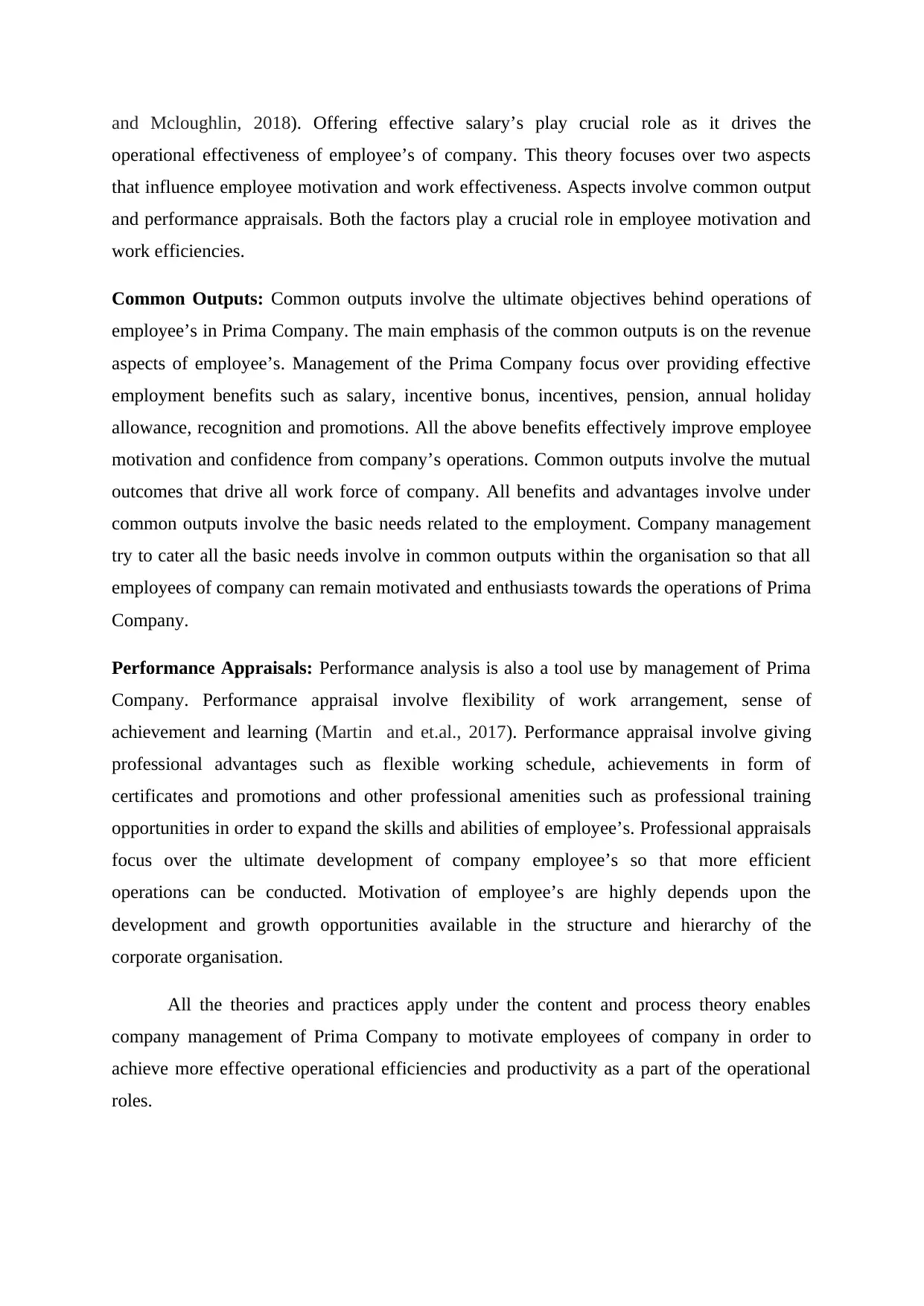
and Mcloughlin, 2018). Offering effective salary’s play crucial role as it drives the
operational effectiveness of employee’s of company. This theory focuses over two aspects
that influence employee motivation and work effectiveness. Aspects involve common output
and performance appraisals. Both the factors play a crucial role in employee motivation and
work efficiencies.
Common Outputs: Common outputs involve the ultimate objectives behind operations of
employee’s in Prima Company. The main emphasis of the common outputs is on the revenue
aspects of employee’s. Management of the Prima Company focus over providing effective
employment benefits such as salary, incentive bonus, incentives, pension, annual holiday
allowance, recognition and promotions. All the above benefits effectively improve employee
motivation and confidence from company’s operations. Common outputs involve the mutual
outcomes that drive all work force of company. All benefits and advantages involve under
common outputs involve the basic needs related to the employment. Company management
try to cater all the basic needs involve in common outputs within the organisation so that all
employees of company can remain motivated and enthusiasts towards the operations of Prima
Company.
Performance Appraisals: Performance analysis is also a tool use by management of Prima
Company. Performance appraisal involve flexibility of work arrangement, sense of
achievement and learning (Martin and et.al., 2017). Performance appraisal involve giving
professional advantages such as flexible working schedule, achievements in form of
certificates and promotions and other professional amenities such as professional training
opportunities in order to expand the skills and abilities of employee’s. Professional appraisals
focus over the ultimate development of company employee’s so that more efficient
operations can be conducted. Motivation of employee’s are highly depends upon the
development and growth opportunities available in the structure and hierarchy of the
corporate organisation.
All the theories and practices apply under the content and process theory enables
company management of Prima Company to motivate employees of company in order to
achieve more effective operational efficiencies and productivity as a part of the operational
roles.
operational effectiveness of employee’s of company. This theory focuses over two aspects
that influence employee motivation and work effectiveness. Aspects involve common output
and performance appraisals. Both the factors play a crucial role in employee motivation and
work efficiencies.
Common Outputs: Common outputs involve the ultimate objectives behind operations of
employee’s in Prima Company. The main emphasis of the common outputs is on the revenue
aspects of employee’s. Management of the Prima Company focus over providing effective
employment benefits such as salary, incentive bonus, incentives, pension, annual holiday
allowance, recognition and promotions. All the above benefits effectively improve employee
motivation and confidence from company’s operations. Common outputs involve the mutual
outcomes that drive all work force of company. All benefits and advantages involve under
common outputs involve the basic needs related to the employment. Company management
try to cater all the basic needs involve in common outputs within the organisation so that all
employees of company can remain motivated and enthusiasts towards the operations of Prima
Company.
Performance Appraisals: Performance analysis is also a tool use by management of Prima
Company. Performance appraisal involve flexibility of work arrangement, sense of
achievement and learning (Martin and et.al., 2017). Performance appraisal involve giving
professional advantages such as flexible working schedule, achievements in form of
certificates and promotions and other professional amenities such as professional training
opportunities in order to expand the skills and abilities of employee’s. Professional appraisals
focus over the ultimate development of company employee’s so that more efficient
operations can be conducted. Motivation of employee’s are highly depends upon the
development and growth opportunities available in the structure and hierarchy of the
corporate organisation.
All the theories and practices apply under the content and process theory enables
company management of Prima Company to motivate employees of company in order to
achieve more effective operational efficiencies and productivity as a part of the operational
roles.
Paraphrase This Document
Need a fresh take? Get an instant paraphrase of this document with our AI Paraphraser
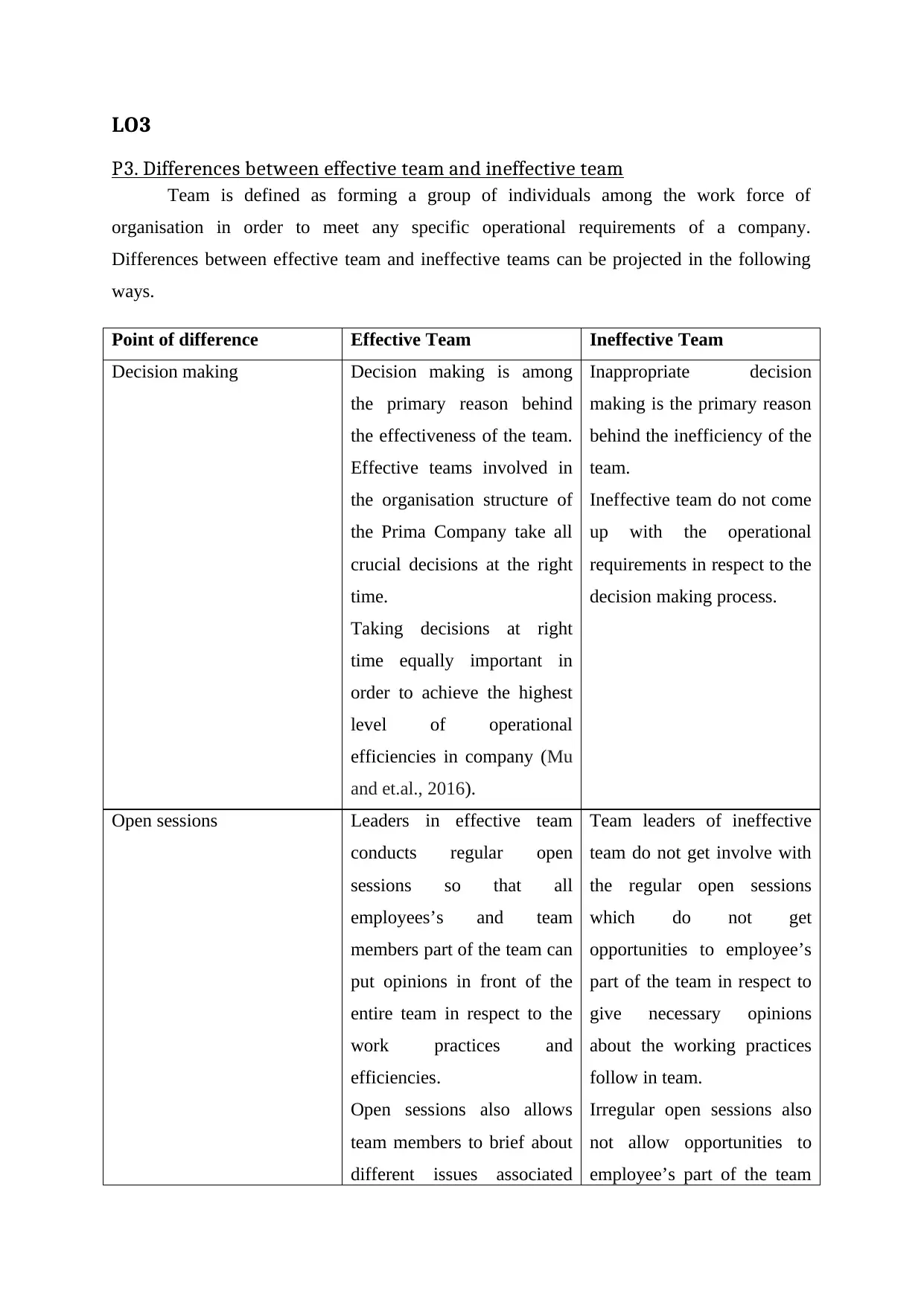
LO3
P3. Differences between effective team and ineffective team
Team is defined as forming a group of individuals among the work force of
organisation in order to meet any specific operational requirements of a company.
Differences between effective team and ineffective teams can be projected in the following
ways.
Point of difference Effective Team Ineffective Team
Decision making Decision making is among
the primary reason behind
the effectiveness of the team.
Effective teams involved in
the organisation structure of
the Prima Company take all
crucial decisions at the right
time.
Taking decisions at right
time equally important in
order to achieve the highest
level of operational
efficiencies in company (Mu
and et.al., 2016).
Inappropriate decision
making is the primary reason
behind the inefficiency of the
team.
Ineffective team do not come
up with the operational
requirements in respect to the
decision making process.
Open sessions Leaders in effective team
conducts regular open
sessions so that all
employees’s and team
members part of the team can
put opinions in front of the
entire team in respect to the
work practices and
efficiencies.
Open sessions also allows
team members to brief about
different issues associated
Team leaders of ineffective
team do not get involve with
the regular open sessions
which do not get
opportunities to employee’s
part of the team in respect to
give necessary opinions
about the working practices
follow in team.
Irregular open sessions also
not allow opportunities to
employee’s part of the team
P3. Differences between effective team and ineffective team
Team is defined as forming a group of individuals among the work force of
organisation in order to meet any specific operational requirements of a company.
Differences between effective team and ineffective teams can be projected in the following
ways.
Point of difference Effective Team Ineffective Team
Decision making Decision making is among
the primary reason behind
the effectiveness of the team.
Effective teams involved in
the organisation structure of
the Prima Company take all
crucial decisions at the right
time.
Taking decisions at right
time equally important in
order to achieve the highest
level of operational
efficiencies in company (Mu
and et.al., 2016).
Inappropriate decision
making is the primary reason
behind the inefficiency of the
team.
Ineffective team do not come
up with the operational
requirements in respect to the
decision making process.
Open sessions Leaders in effective team
conducts regular open
sessions so that all
employees’s and team
members part of the team can
put opinions in front of the
entire team in respect to the
work practices and
efficiencies.
Open sessions also allows
team members to brief about
different issues associated
Team leaders of ineffective
team do not get involve with
the regular open sessions
which do not get
opportunities to employee’s
part of the team in respect to
give necessary opinions
about the working practices
follow in team.
Irregular open sessions also
not allow opportunities to
employee’s part of the team
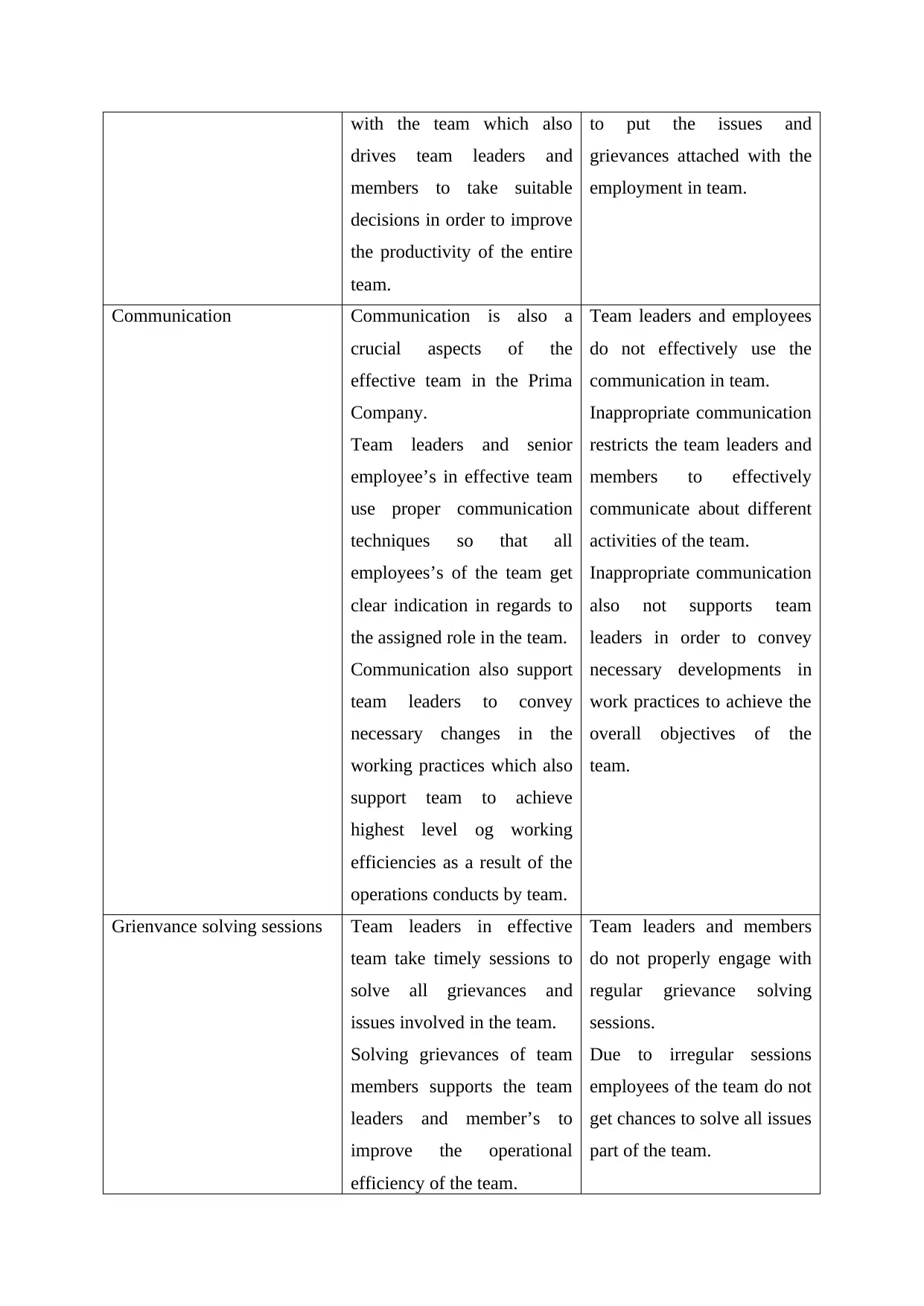
with the team which also
drives team leaders and
members to take suitable
decisions in order to improve
the productivity of the entire
team.
to put the issues and
grievances attached with the
employment in team.
Communication Communication is also a
crucial aspects of the
effective team in the Prima
Company.
Team leaders and senior
employee’s in effective team
use proper communication
techniques so that all
employees’s of the team get
clear indication in regards to
the assigned role in the team.
Communication also support
team leaders to convey
necessary changes in the
working practices which also
support team to achieve
highest level og working
efficiencies as a result of the
operations conducts by team.
Team leaders and employees
do not effectively use the
communication in team.
Inappropriate communication
restricts the team leaders and
members to effectively
communicate about different
activities of the team.
Inappropriate communication
also not supports team
leaders in order to convey
necessary developments in
work practices to achieve the
overall objectives of the
team.
Grienvance solving sessions Team leaders in effective
team take timely sessions to
solve all grievances and
issues involved in the team.
Solving grievances of team
members supports the team
leaders and member’s to
improve the operational
efficiency of the team.
Team leaders and members
do not properly engage with
regular grievance solving
sessions.
Due to irregular sessions
employees of the team do not
get chances to solve all issues
part of the team.
drives team leaders and
members to take suitable
decisions in order to improve
the productivity of the entire
team.
to put the issues and
grievances attached with the
employment in team.
Communication Communication is also a
crucial aspects of the
effective team in the Prima
Company.
Team leaders and senior
employee’s in effective team
use proper communication
techniques so that all
employees’s of the team get
clear indication in regards to
the assigned role in the team.
Communication also support
team leaders to convey
necessary changes in the
working practices which also
support team to achieve
highest level og working
efficiencies as a result of the
operations conducts by team.
Team leaders and employees
do not effectively use the
communication in team.
Inappropriate communication
restricts the team leaders and
members to effectively
communicate about different
activities of the team.
Inappropriate communication
also not supports team
leaders in order to convey
necessary developments in
work practices to achieve the
overall objectives of the
team.
Grienvance solving sessions Team leaders in effective
team take timely sessions to
solve all grievances and
issues involved in the team.
Solving grievances of team
members supports the team
leaders and member’s to
improve the operational
efficiency of the team.
Team leaders and members
do not properly engage with
regular grievance solving
sessions.
Due to irregular sessions
employees of the team do not
get chances to solve all issues
part of the team.
⊘ This is a preview!⊘
Do you want full access?
Subscribe today to unlock all pages.

Trusted by 1+ million students worldwide
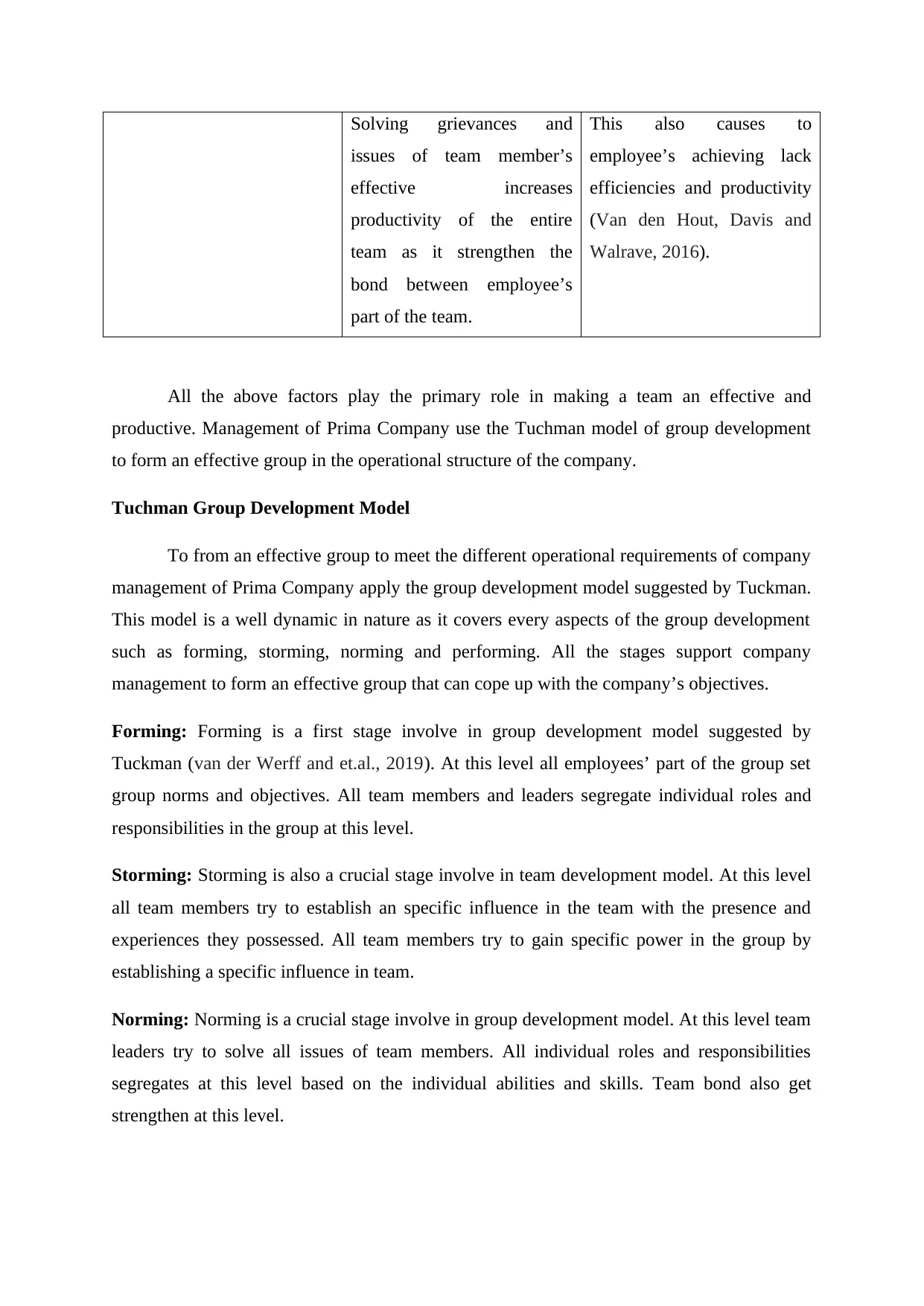
Solving grievances and
issues of team member’s
effective increases
productivity of the entire
team as it strengthen the
bond between employee’s
part of the team.
This also causes to
employee’s achieving lack
efficiencies and productivity
(Van den Hout, Davis and
Walrave, 2016).
All the above factors play the primary role in making a team an effective and
productive. Management of Prima Company use the Tuchman model of group development
to form an effective group in the operational structure of the company.
Tuchman Group Development Model
To from an effective group to meet the different operational requirements of company
management of Prima Company apply the group development model suggested by Tuckman.
This model is a well dynamic in nature as it covers every aspects of the group development
such as forming, storming, norming and performing. All the stages support company
management to form an effective group that can cope up with the company’s objectives.
Forming: Forming is a first stage involve in group development model suggested by
Tuckman (van der Werff and et.al., 2019). At this level all employees’ part of the group set
group norms and objectives. All team members and leaders segregate individual roles and
responsibilities in the group at this level.
Storming: Storming is also a crucial stage involve in team development model. At this level
all team members try to establish an specific influence in the team with the presence and
experiences they possessed. All team members try to gain specific power in the group by
establishing a specific influence in team.
Norming: Norming is a crucial stage involve in group development model. At this level team
leaders try to solve all issues of team members. All individual roles and responsibilities
segregates at this level based on the individual abilities and skills. Team bond also get
strengthen at this level.
issues of team member’s
effective increases
productivity of the entire
team as it strengthen the
bond between employee’s
part of the team.
This also causes to
employee’s achieving lack
efficiencies and productivity
(Van den Hout, Davis and
Walrave, 2016).
All the above factors play the primary role in making a team an effective and
productive. Management of Prima Company use the Tuchman model of group development
to form an effective group in the operational structure of the company.
Tuchman Group Development Model
To from an effective group to meet the different operational requirements of company
management of Prima Company apply the group development model suggested by Tuckman.
This model is a well dynamic in nature as it covers every aspects of the group development
such as forming, storming, norming and performing. All the stages support company
management to form an effective group that can cope up with the company’s objectives.
Forming: Forming is a first stage involve in group development model suggested by
Tuckman (van der Werff and et.al., 2019). At this level all employees’ part of the group set
group norms and objectives. All team members and leaders segregate individual roles and
responsibilities in the group at this level.
Storming: Storming is also a crucial stage involve in team development model. At this level
all team members try to establish an specific influence in the team with the presence and
experiences they possessed. All team members try to gain specific power in the group by
establishing a specific influence in team.
Norming: Norming is a crucial stage involve in group development model. At this level team
leaders try to solve all issues of team members. All individual roles and responsibilities
segregates at this level based on the individual abilities and skills. Team bond also get
strengthen at this level.
Paraphrase This Document
Need a fresh take? Get an instant paraphrase of this document with our AI Paraphraser
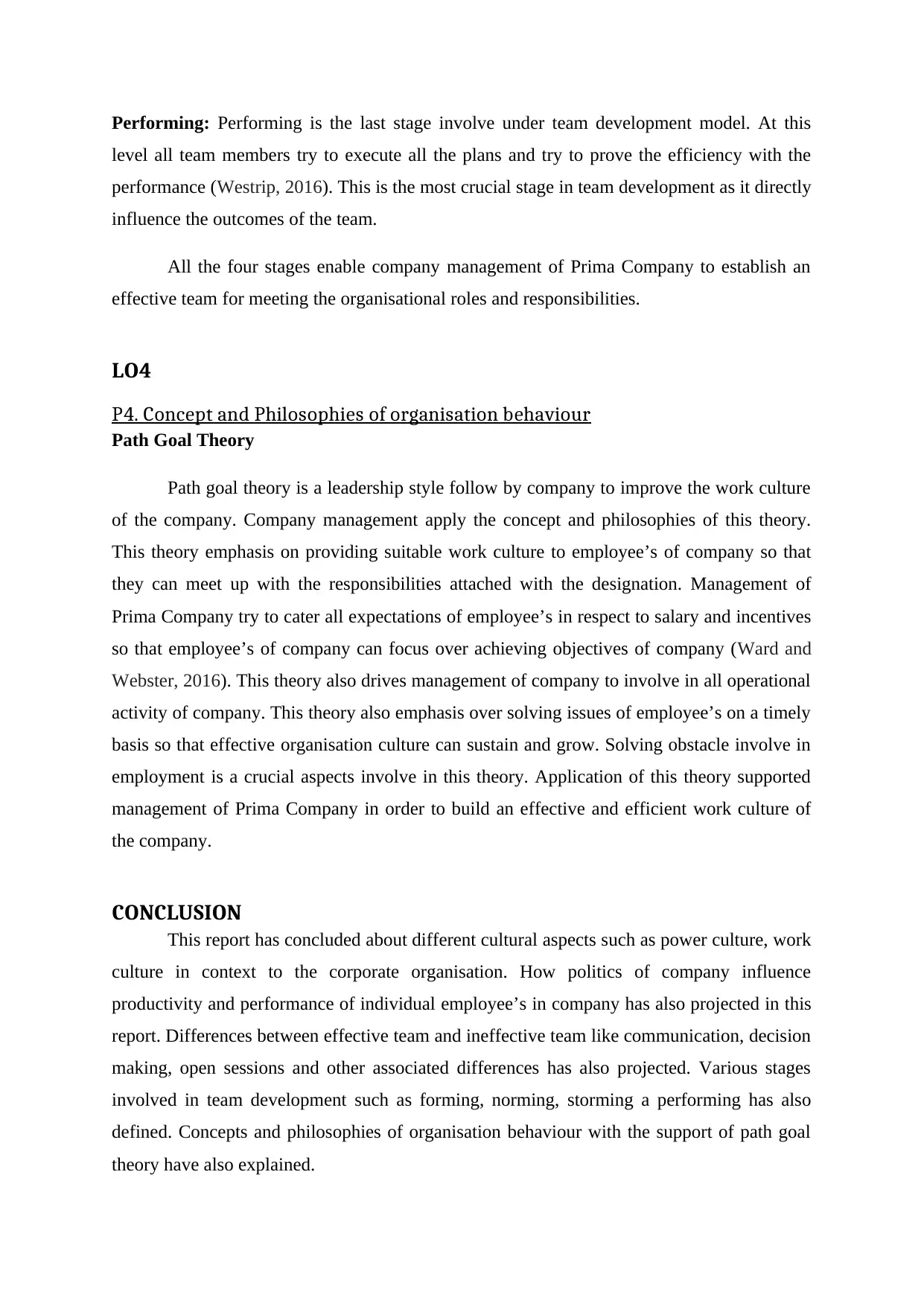
Performing: Performing is the last stage involve under team development model. At this
level all team members try to execute all the plans and try to prove the efficiency with the
performance (Westrip, 2016). This is the most crucial stage in team development as it directly
influence the outcomes of the team.
All the four stages enable company management of Prima Company to establish an
effective team for meeting the organisational roles and responsibilities.
LO4
P4. Concept and Philosophies of organisation behaviour
Path Goal Theory
Path goal theory is a leadership style follow by company to improve the work culture
of the company. Company management apply the concept and philosophies of this theory.
This theory emphasis on providing suitable work culture to employee’s of company so that
they can meet up with the responsibilities attached with the designation. Management of
Prima Company try to cater all expectations of employee’s in respect to salary and incentives
so that employee’s of company can focus over achieving objectives of company (Ward and
Webster, 2016). This theory also drives management of company to involve in all operational
activity of company. This theory also emphasis over solving issues of employee’s on a timely
basis so that effective organisation culture can sustain and grow. Solving obstacle involve in
employment is a crucial aspects involve in this theory. Application of this theory supported
management of Prima Company in order to build an effective and efficient work culture of
the company.
CONCLUSION
This report has concluded about different cultural aspects such as power culture, work
culture in context to the corporate organisation. How politics of company influence
productivity and performance of individual employee’s in company has also projected in this
report. Differences between effective team and ineffective team like communication, decision
making, open sessions and other associated differences has also projected. Various stages
involved in team development such as forming, norming, storming a performing has also
defined. Concepts and philosophies of organisation behaviour with the support of path goal
theory have also explained.
level all team members try to execute all the plans and try to prove the efficiency with the
performance (Westrip, 2016). This is the most crucial stage in team development as it directly
influence the outcomes of the team.
All the four stages enable company management of Prima Company to establish an
effective team for meeting the organisational roles and responsibilities.
LO4
P4. Concept and Philosophies of organisation behaviour
Path Goal Theory
Path goal theory is a leadership style follow by company to improve the work culture
of the company. Company management apply the concept and philosophies of this theory.
This theory emphasis on providing suitable work culture to employee’s of company so that
they can meet up with the responsibilities attached with the designation. Management of
Prima Company try to cater all expectations of employee’s in respect to salary and incentives
so that employee’s of company can focus over achieving objectives of company (Ward and
Webster, 2016). This theory also drives management of company to involve in all operational
activity of company. This theory also emphasis over solving issues of employee’s on a timely
basis so that effective organisation culture can sustain and grow. Solving obstacle involve in
employment is a crucial aspects involve in this theory. Application of this theory supported
management of Prima Company in order to build an effective and efficient work culture of
the company.
CONCLUSION
This report has concluded about different cultural aspects such as power culture, work
culture in context to the corporate organisation. How politics of company influence
productivity and performance of individual employee’s in company has also projected in this
report. Differences between effective team and ineffective team like communication, decision
making, open sessions and other associated differences has also projected. Various stages
involved in team development such as forming, norming, storming a performing has also
defined. Concepts and philosophies of organisation behaviour with the support of path goal
theory have also explained.
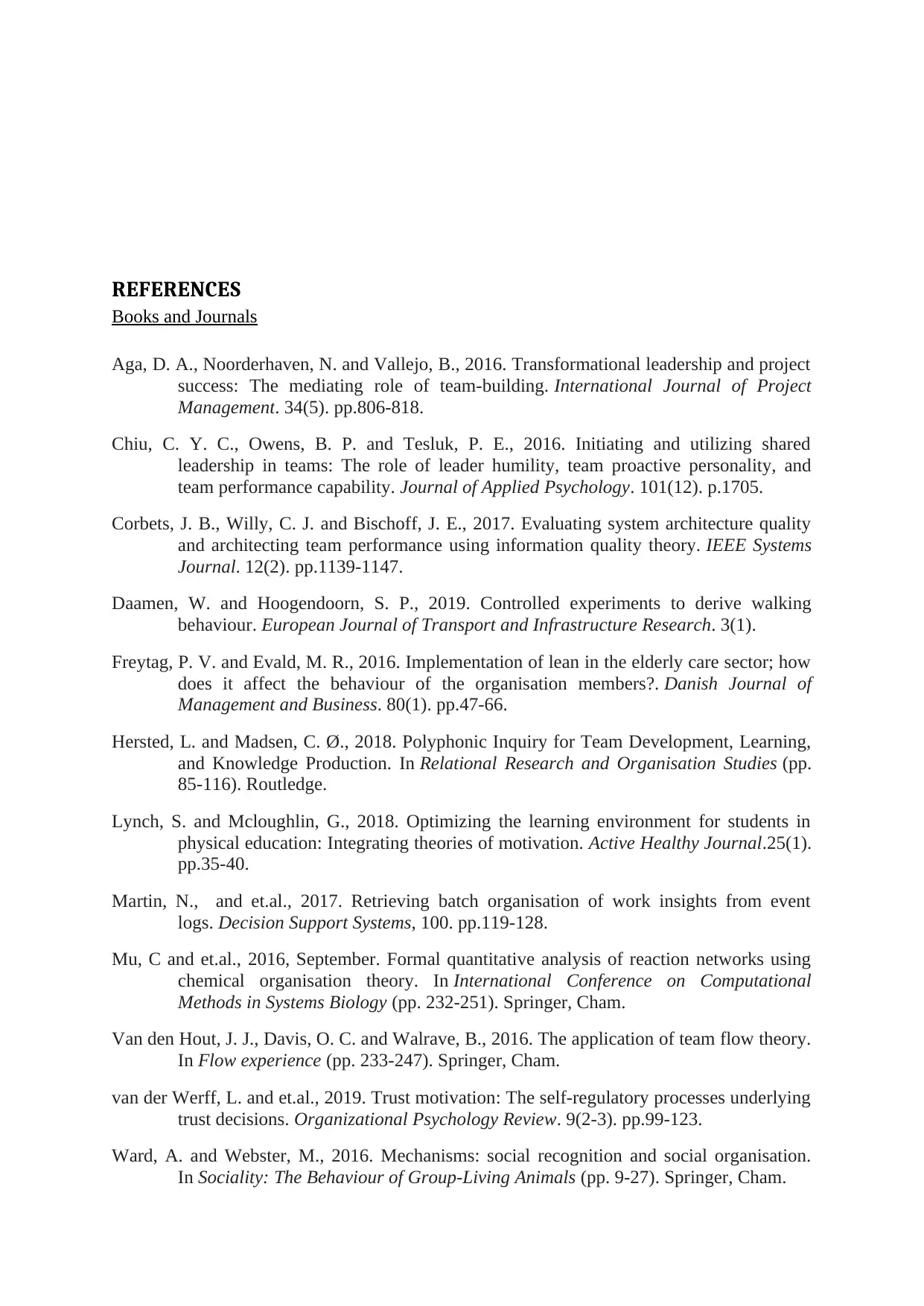
REFERENCES
Books and Journals
Aga, D. A., Noorderhaven, N. and Vallejo, B., 2016. Transformational leadership and project
success: The mediating role of team-building. International Journal of Project
Management. 34(5). pp.806-818.
Chiu, C. Y. C., Owens, B. P. and Tesluk, P. E., 2016. Initiating and utilizing shared
leadership in teams: The role of leader humility, team proactive personality, and
team performance capability. Journal of Applied Psychology. 101(12). p.1705.
Corbets, J. B., Willy, C. J. and Bischoff, J. E., 2017. Evaluating system architecture quality
and architecting team performance using information quality theory. IEEE Systems
Journal. 12(2). pp.1139-1147.
Daamen, W. and Hoogendoorn, S. P., 2019. Controlled experiments to derive walking
behaviour. European Journal of Transport and Infrastructure Research. 3(1).
Freytag, P. V. and Evald, M. R., 2016. Implementation of lean in the elderly care sector; how
does it affect the behaviour of the organisation members?. Danish Journal of
Management and Business. 80(1). pp.47-66.
Hersted, L. and Madsen, C. Ø., 2018. Polyphonic Inquiry for Team Development, Learning,
and Knowledge Production. In Relational Research and Organisation Studies (pp.
85-116). Routledge.
Lynch, S. and Mcloughlin, G., 2018. Optimizing the learning environment for students in
physical education: Integrating theories of motivation. Active Healthy Journal.25(1).
pp.35-40.
Martin, N., and et.al., 2017. Retrieving batch organisation of work insights from event
logs. Decision Support Systems, 100. pp.119-128.
Mu, C and et.al., 2016, September. Formal quantitative analysis of reaction networks using
chemical organisation theory. In International Conference on Computational
Methods in Systems Biology (pp. 232-251). Springer, Cham.
Van den Hout, J. J., Davis, O. C. and Walrave, B., 2016. The application of team flow theory.
In Flow experience (pp. 233-247). Springer, Cham.
van der Werff, L. and et.al., 2019. Trust motivation: The self-regulatory processes underlying
trust decisions. Organizational Psychology Review. 9(2-3). pp.99-123.
Ward, A. and Webster, M., 2016. Mechanisms: social recognition and social organisation.
In Sociality: The Behaviour of Group-Living Animals (pp. 9-27). Springer, Cham.
Books and Journals
Aga, D. A., Noorderhaven, N. and Vallejo, B., 2016. Transformational leadership and project
success: The mediating role of team-building. International Journal of Project
Management. 34(5). pp.806-818.
Chiu, C. Y. C., Owens, B. P. and Tesluk, P. E., 2016. Initiating and utilizing shared
leadership in teams: The role of leader humility, team proactive personality, and
team performance capability. Journal of Applied Psychology. 101(12). p.1705.
Corbets, J. B., Willy, C. J. and Bischoff, J. E., 2017. Evaluating system architecture quality
and architecting team performance using information quality theory. IEEE Systems
Journal. 12(2). pp.1139-1147.
Daamen, W. and Hoogendoorn, S. P., 2019. Controlled experiments to derive walking
behaviour. European Journal of Transport and Infrastructure Research. 3(1).
Freytag, P. V. and Evald, M. R., 2016. Implementation of lean in the elderly care sector; how
does it affect the behaviour of the organisation members?. Danish Journal of
Management and Business. 80(1). pp.47-66.
Hersted, L. and Madsen, C. Ø., 2018. Polyphonic Inquiry for Team Development, Learning,
and Knowledge Production. In Relational Research and Organisation Studies (pp.
85-116). Routledge.
Lynch, S. and Mcloughlin, G., 2018. Optimizing the learning environment for students in
physical education: Integrating theories of motivation. Active Healthy Journal.25(1).
pp.35-40.
Martin, N., and et.al., 2017. Retrieving batch organisation of work insights from event
logs. Decision Support Systems, 100. pp.119-128.
Mu, C and et.al., 2016, September. Formal quantitative analysis of reaction networks using
chemical organisation theory. In International Conference on Computational
Methods in Systems Biology (pp. 232-251). Springer, Cham.
Van den Hout, J. J., Davis, O. C. and Walrave, B., 2016. The application of team flow theory.
In Flow experience (pp. 233-247). Springer, Cham.
van der Werff, L. and et.al., 2019. Trust motivation: The self-regulatory processes underlying
trust decisions. Organizational Psychology Review. 9(2-3). pp.99-123.
Ward, A. and Webster, M., 2016. Mechanisms: social recognition and social organisation.
In Sociality: The Behaviour of Group-Living Animals (pp. 9-27). Springer, Cham.
⊘ This is a preview!⊘
Do you want full access?
Subscribe today to unlock all pages.

Trusted by 1+ million students worldwide
1 out of 13
Related Documents
Your All-in-One AI-Powered Toolkit for Academic Success.
+13062052269
info@desklib.com
Available 24*7 on WhatsApp / Email
![[object Object]](/_next/static/media/star-bottom.7253800d.svg)
Unlock your academic potential
Copyright © 2020–2025 A2Z Services. All Rights Reserved. Developed and managed by ZUCOL.




